2. 中国科学院大学, 北京 100049;
3. 国家红壤改良工程技术研究中心, 中国科学院红壤生态实验站, 江西鹰潭 335211;
4. 江西省重金属污染生态修复工程技术研究中心, 南昌 330096
土壤是支撑经济社会可持续发展的重要物质基础。土壤重金属的来源有两种,一是自然来源:成土母岩本身含有的重金属;二是人为来源:含重金属的大气沉降,农药和肥料使用,污水灌溉和污泥农用,含重金属固废堆积和金属矿山酸性废水污染等[1-4]。因其在土壤中毒性强、具有生物累积效应等特征受到科学家们的广泛关注[5-6]。《2014全国土壤污染状况调查公报》显示全国土壤总的污染物点位超标率为16.1%,其中,重金属等无机类污染物占总超标点位的82.8%[7]。有资料表明中国由于镉、砷、铬、铅等重金属污染的耕地面积近2000万hm2,约占总耕地面积的1/5[8]。以上数据表明全国土壤环境状况总体不容乐观,尤其是土壤重金属污染问题。目前有关土壤重金属污染治理技术研究报道较多,对已有研究涉及的土壤重金属污染修复领域的热点趋势、研究方向的变化等计量分析的较少,缺少从研究领域,研究方向、热点趋势等角度分析预测未来该领域的研究或技术创新的文章。
文献计量学方法是对文献和文献工作进行定量的方法,它的基础在“量”,所以必须进行一系列的统计工作以获得必要的数据,通过数据分析从中找出变化规律,进而预测未来的发展趋势[9-11]。文献计量学已应用在环境工程与科学、土壤学、生态学、食品安全、新能源利用等方面,研究方法较为成熟[12-16]。Web of ScienceTM核心合集数据库是一个包含自然科学、工程技术、社会科学等领域、提供高质量、可信赖的学术信息检索的跨库平台[17]。H指数,是指一个国家(或机构、科研人员)有N篇论文分别被引用了至少N次,该值越高,表明它的论文影响力越大[18]。运用HistCite软件中重要参数本地总引用次数(Total local citation score,TLCS)、总引用次数(Total global citation score,TGCS)和本地引用次数(Local citation score,LCS)三个指标,可快速定位本领域的重要作者、重要机构、重要期刊等,TLCS表示的是某一篇文章被导入HistCite进行分析的这几百或几千篇文献所引用的次数,导入Histcite的文章均是与检索词有关的, 所以这些文章与研究方向相关,若某一篇文献的TLCS值越高,说明该文献在该研究领域内影响越大;TGCS表示某一篇文章被整个Web of Science(WOS)数据库中的文献所引用的次数。相比而言,TLCS较TGCS更重要,TLCS高的极有可能是领域内的开创性文章,LCS表示某篇文献在当前数据集中被引用的次数[19]。VOSviewer可视化分析软件是由荷兰莱顿大学开发的一款免费可视化分析软件,可以对重要文献、高产作者、关键词、机构进行聚类共现可视化分析[20]。
本研究基于Web of ScienceTM核心合集数据库,利用WOS数据库自带的分析工具、HistCite软件、VOSviewer软件和Origin 9.1软件,对2000—2016年间发表的有关土壤重金属污染修复研究文献进行计量分析,以期为土壤重金属污染修复提供调研学科研究方向、聚焦学科研究主题、跟踪学科动态等提供支持或者帮助。
1 材料与方法 1.1 数据来源利用美国汤森路透公司(Thomson Reuters)WOS数据库,检索时间段为2000年1月1日至2016年12月31日,检索时间2017年5月9日,以主题词Topic =(soil* or field or farmland* or cropland* or land*)and(“heavy metal*”or lead or “black lead”or plumbum or cadmium or mercury or hydrargyrum or quicksilver or chromium or chrome or arsenic or copper or zinc or nickel)and(contaminat* or pollut*)and(removal or decontaminal or stabilizat* or phytoremediat* or bioremediat* or co-remediat* or phytostabilizat* or phytoinfiltrat* or hyperaccumulate or remediat* or repair or restore*)作为检索式,在Web of ScienceTM核心合集数据库中检索发表于2000—2016年世界土壤重金属污染修复研究文献9 945篇,导入HistCite软件的文献共9 940篇。
1.2 统计方法利用WOS数据库自带的分析工具、HistCite软件、VOSviewer软件和Origin 9.1软件,对2000—2016年间发表的有关土壤重金属污染修复技术文献从国家/地区发文量、高产作者、重要研究机构、来源期刊分析、研究方向及研究热点等方面进行计量分析。其中用HistCite软件、VOS viewer软件进行数据分析时,是将从Web of Science数据库下载的txt格式的文章,按照研究内容的需要将文本导入至HistCite软件、VOS viewer软件,然后进行分析。
2 结果 2.1 2000—2016年发文量TOP10的国家/地区总发文量论文被SCI收录的数量和被引频次反映了一个国家/地区的整体科研实力和影响力[21-23]。从Web of ScienceTM核心合集数据库中共检索出中国、美国、印度、西班牙、意大利等108个国家/地区发表了有关土壤重金属修复技术的研究论文。在现有数据基础上,对2000—2016年不同国家/地区的发文情况进行分析。论文发表数量排名前10位的国家/地区(以下简称TOP10国家/地区)如表 1所示,中国的发文量位居榜首,共2 105篇,但均篇被引频次为14.33,排名最后。中国H指数为71,仅次于美国。美国的发文量仅低于中国,但是其总被引次数和H指数显著高于其他国家/地区。英国的论文均篇被引次数最高,说明其文章影响力较强。用VOSviewer可视化分析软件作出2000—2016年土壤重金属污染修复研究中国大陆和台湾地区以及世界各国之间的合作关系图,图中圈大小表示某个国家/地区的活跃程度及文章的发表数量,国家/地区之间的连线距离表示国家/地区间的合作密切程度,距离越小,表示国家/地区间的合作越密切。从图 1可知,各个国家/地区之间合作密切,共同致力于为土壤污染修作贡献,其中中国的合作密切国家主要是美国、日本、澳大利亚、英格兰、印度和法国。
|
|
表 1 2000—2016年土壤重金属污染修复研究发文量排名TOP10的国家/地区 Table 1 Top10 countries or regions in volume of publications in the field of remediation of heavy mental contaminated soils during the period from 2000 to 2016 |
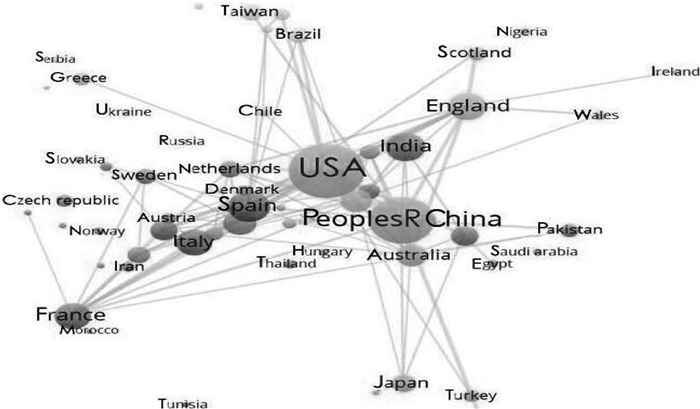
|
图 1 2000—2016年土壤重金属污染修复研究中国大陆和台湾地区以及世界各国之间的合作关系 Fig. 1 Cooperation between China (including Taiwan)and other countries in the field of remediation of heavy mental contaminated soils during the period from 2000 to 2016 |
对作者的分析,有利于发现该领域的高产出研究人员,通过作者的发文数量、被引频次可以找到重要作者[24]。该领域研究论文共涉及6815位作者。发文量TOP10的作者如表 2所示。按TLCS排序,美国学者Ma L Q排名第一,其TLCS值为1201,比利时学者Vangronsveld J排名第二,其TLCS值为915,澳大利亚学者Naidu R的TLCS值最低,其值为257,LCS值越高意味着该文献越重要。按TGCS排序,前三名分别为美国学者Ma L Q、比利时学者Vangronsveld J和中国学者Zhou QX。按H指数排序,前两名分别为美国学者Ma L Q、中国学者Zhou Q X,其H值分别为32和24,最低为中国学者He Z L。从表 2可以看出,TOP10的高产作者中,中国有4位(包括周启星、杨肖娥,骆永明和何振立),美国有3位。图 2表示该领域重要作者之间的合作关系图,从图可以清晰地看出各个学者之间直接或间接的合作。如图所示,不同的颜色代表不同的群组,通过节点的颜色、大小、聚类结果来判读不同组群的强度及其相互作用关系。美国学者Ma L Q与中国学者Yang X E与He Z L合作,比利时学者Vangronsveld J与法国学者Mench M,Zhou Q X与Ma L Q以及Yang X E与He Z L有直接合作关系。Luo Y M与Yang X E、He Z L及Zhou Q X有间接合作关系。
|
|
表 2 2000—2016年土壤重金属污染修复研究发文量排名TOP10的高产作者 Table 2 Top10 high yield authors in the field of remediation of heavy mental contaminated soils during the period from 2000 to 2016 |
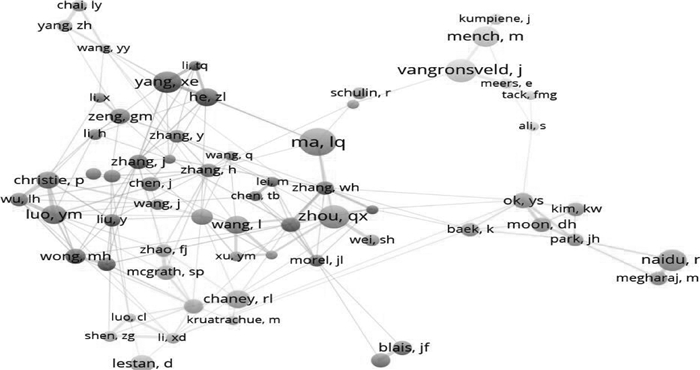
|
图 2 2000—2016年土壤重金属污染修复研究重要作者之间的合作关系 Fig. 2 Collaborative relationships between important authors in the field of remediation of heavy mental contaminated soils during the period from 2000 to 2016 |
通过分析,该领域研究论文共涉及2186个研究机构,排名TOP10的研究机构如表 3,2000—2016年中国科学院在土壤重金属污染修复技术领域的发文量为662篇,远高于排名第二的浙江大学(158篇)和第三的美国佛罗里达大学(144篇)。TOP10的研究机构来自中国的有中国科学院、浙江大学、南京农业大学、中山大学、台湾大学,占TOP10研究机构的50%,美国仅随其后,有佛罗里达大学和美国环保署。图 3表示该领域重要研究机构之间的合作关系图,从图中可以看出各个研究机构之间的合作关系,其中中国科学院与浙江大学、佛罗里达大学、南京农业大学及台湾大学等研究机构均有合作,中国科学院在土壤重金属污染修复领域占有举足轻重的作用。
|
|
表 3 2000—2016年土壤重金属污染修复研究发文量排名TOP10的研究机构 Table 3 Top10 institutions in volume of publications in the field of remediation of heavy mental contaminated soils during the period from 2000 to 2016 |
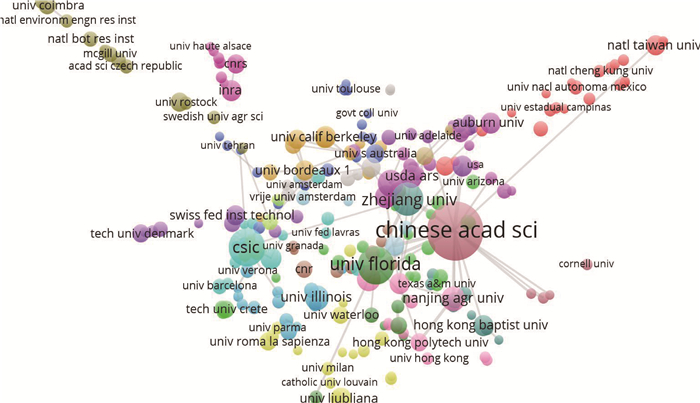
|
图 3 2000—2016年土壤重金属污染修复研究重要机构之间的合作关系 Fig. 3 Collaborative relationships between important institutions in the field of remediation of heavy mental contaminated soils during the period from 2000 to 2016 |
对某一研究领域的期刊进行分析,可确定该领域SCI来源的核心期刊。影响因子是期刊影响力的一种计算方法,即某期刊前两年发表的论文在统计当年的被引用总次数除以该期刊在前两年内发表的论文总数[25]。该领域共有790家期刊参与,发文量TOP10的期刊如表 4所示。2015年影响因子最高的为期刊Environmental Science & Technology,其影响因子为5.393,其次是Environmental Pollution和Journal of Hazardous Materials,影响因子分别为4.839和4.836;最低的为期刊Water Air and Soil Pollution,其影响因子为1.771。TOP10期刊的主要出版商为Elsevier和Springer。根据TLCS分析,期刊Chemosphere、Environmental Pollution、Journal of Hazardous Materials的TLCS值分别为4 970、4 233、3 832,这三种期刊均为该领域影响力较高的期刊。
|
|
表 4 2000—2016年土壤重金属污染修复研究发文量排名TOP10的期刊 Table 4 Top10 journals of publications in the field of remediation of heavy mental contaminated soils during the period from 2000 to 2016 |
通过分析,从2000—2016年排名TOP10的研究方向的变化情况如图 4所示,主要研究方向为环境科学与生态学(Environmental Sciences & Ecology),其次是工程学(Engineering),然后是农学(Agriculture)、水资源学(Water Resources)、化学(Chemistry)、生物技术与应用微生物学(Biotechnology & Applied Microbiology)、植物科学(Plant Sciences)、毒理学(Toxicology)等。从表中可以看出土壤重金属污染修复涉及的学科领域分布广泛,以环境科学与生态学、工程学领域研究为主,并且逐渐向其他学科领域渗透,学科之间的交互研究将会更为普遍。表 5反映的是2000—2005、2006—2010、2011—2016三个时间段该领域TOP10的研究方向的变化趋势,从表中可以看出,三个时间段内该领域研究方向没有大的变化,主要还是侧重于在环境科学与生态学、工程学、农学和水资源学方面的研究。
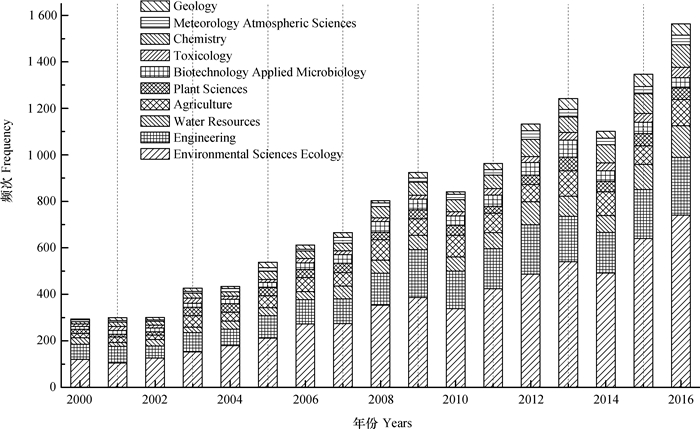
|
图 4 2000—2016年土壤重金属污染修复领域的研究方向 Fig. 4 Research direction in the field of remediation of heavy mental contaminated soils during the period from 2000 to 2016 |
|
|
表 5 2000—2005、2006—2010、2011—2016三个时间段土壤重金属污染修复领域的研究方向 Table 5 Research directions in the field of remediation of heavy mental contaminated soils during the periods of 2000—2005, 2006—2010, 2011—2016 |
文章的被引频次在一定程度上反映了人们对某项研究工作的关注程度,可以显示科学论文在科研过程中被使用和受重视的程度,以及在学术交流中的作用和地位。目前的研究评价中,被引频次被越来越多地用于衡量论文重要性的指标。该领域被引频次TOP10论文见表 6。按LCS排序,加拿大作者Mulligan C N发表的Remediation technologies for metal-contaminated soils and groundwater:An evaluation被引频次最高。这10篇高被引论文由5位英国作者、2位美国作者等作者发表。利用HistCite软件,LCS排名TOP30论文引文关系图谱如图 5所示,编号304的文献被引力度最大,编号794的文献和编号2 676的文献也是高被引的文献,同时它们对TOP30的其他文献的产出也有重要影响。按LCS排名,TOP30论文之间共被引关系清晰明了。
|
|
表 6 2000—2016年土壤重金属污染修复研究领域TOP10的高被引论文 Table 6 Top10 highly cited papers in the field of remediation of heavy mental contaminated soils during the period from 2000 to 2016 |
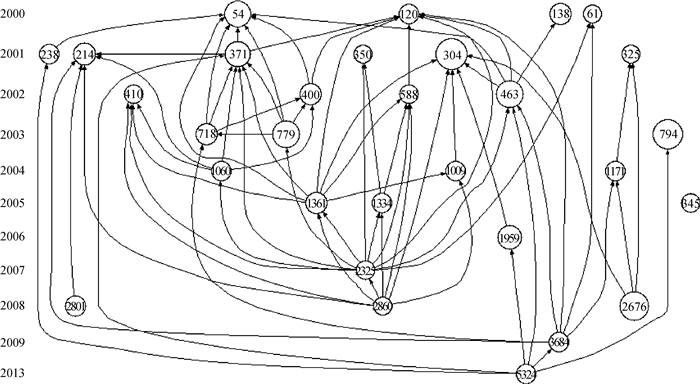
|
图 5 2000—2016年土壤重金属污染修复研究领域TOP30的高被引论文之间的引文关系图谱 Fig. 5 HistCite of top30 highly cited papers in the field of remediation of heavy mental contaminated during the period from 2000 to 2016 |
对主题词的分析可以反映该领域研究热点。利用VOSviewer软件构建国内外土壤重金属污染修复主题的知识图谱,从图 6、图 7可知,近些年国内外科研人员均对重金属Cd(Cadmium)、Pb(Lead)、Cu(Copper)、As(Arsenic)、Zn(Zinc)的研究较热。同时土壤重金属污染修复研究常与地下水,污水中重金属修复相关研究联系在一起。中国土壤重金属污染的修复技术主要有植物修复(Phytoremediation)、生物修复(Bioremediation)、固化/稳定化修复(Stabilization/Immobilization)。国外的除了前三种修复技术,还有电动修复(electrokinetic remediation)。植物修复常用的超积累植物有印度芥菜(Indian mustard)、遏蓝菜又名败酱草(thlaspi-caerulescaens)。常用固化剂有粉煤灰(fly-ash)、磷灰石(apatite)、磷酸盐(phosphate)等。中国的土壤重金属污染修复区域常在酸性土壤上,例如红壤(red soil)。

|
图 6 2000—2016年中国土壤重金属污染修复研究热点分布 Fig. 6 Distribution of hot spots in the field of remediation of heavy mental contaminated soils during the period from 2000 to 2016 in China |

|
图 7 2000—2016年国外土壤重金属污染修复研究热点分布 Fig. 7 Distribution of hot spots in the field of remediation of heavy mental contaminated soil during the period from 2000 to 2016 in other countries than China |
基于Web of Science数据库,通过对2000—2016年间发表的有关土壤重金属污染修复研究文献进行计量分析,相比于欧美国家,我国的发文量最高,均篇被引次数较低,降低了国际影响力,因此,我们的科研人员不仅要重视发文数量,还要注重提高论文的质量。其中国家/地区之间的合作有利于了解国际研究形势和加强土壤污染修复技术交流。在TOP10的高产作者中,中国有4位,分别为南开大学周启星教授、浙江大学杨肖娥和何振立教授、中国科学院烟台海岸带研究所骆永明研究员,美国有3位,说明美国和中国研究人员在土壤重金属污染修复领域的研究具有较高影响力。分析高产作者有利于了解其组内成员;收集其研究项目;梳理其学术思想;洞察其仪器资源;跟踪其研究成果。对高产作者间的合作分析有利于机构的人才招聘;选择小同行审稿专家;选择潜在的合作者[28-29]。
在对重要研究机构的分析中,我国有中国科学院、浙江大学、南京农业大学、中山大学、台湾大学5所单位进入TOP10研究机构,由此可以看出我国科研院所以及高校在土壤重金属修复方面做出的贡献。土壤重金属污染修复的研究文章主要发表在Journal of Hazardous Materials、Chemosphere、Environmental Pollution、Science of the Total Environment、Environmental Science & Technology,这些期刊也是该领域认可度较高的期刊,对期刊的分析有利于跟踪最新科研信息,选择写作投稿的期刊[30]。
TOP10的论文之所以被引频次较高,主要有两方面原因,一是TOP10的文章有4篇是综述性文献,综述为高度凝练总结前期研究成果的文献,文章质量较高,例如瑞典作者Kumpiene和Lagerkvist[5]发表的Stabilization of As, Cr, Cu, Pb and Zn in soil using amendments - A review,总结分析了固化/稳定化修复技术中不同改良剂在修复土壤As、Cr、Cu、Pb和Zn污染的应用、机制与原理,对前人的研究成果进行了高度概括;二是论文的关键词Keywords、Keywords Plus和本文检索主题词有极大地交集,例如,加拿大作者Mulligan和Yong[26]发表的Remediation technologies for metal-contaminated soils and groundwater: An evaluation,其文章关键词Keywords: soil; remediation technologies; groundwater; sediments; heavy metals. Keywords Plus: Sewage-sludge; heavy-metals; trace-metals; fractionation; sediments; cadmium; removal; water。
该领域主要研究方向为环境科学与生态学(Environmental Sciences & Ecology),其次是工程学(Engineering),然后是农学(Agriculture)、水资源学(Water Resources),而相对弱化了对地质学(Geology)、毒理学(Toxicology)方面的研究。分析一个领域的研究方向有利于科研人员掌握该领域的研究重点,为开展下一步的科研工作提供有力的支持[31]。土壤重金属污染修复技术主要有植物修复、生物修复、电动修复和固化/稳定化修复技术,其中国内外常用修复技术均为植物修复(主要为植物提取)和生物修复,该研究结果与串丽敏等[21]、朱宇恩等[27]的研究结果一致。其中主要研究对象均为重金属镉(Cd)、铅(Pb)、铜(Cu)、锌(Zn)和类重金属砷(As)等,说明国内外在该领域的研究修复技术和研究对象几乎一致。
本文的亮点之处是对高产作者、国家/地区发文量、重要研究机构、高被引论文等分析均用多个指标进行比较分析,特别是用VOSviewer可视化图谱分析了重要作者和国家/地区之间的合作关系,用Histcite引文图谱分析软件对TOP30高被引论文进行分析,结果可以看出,该研究领域未来研究的方向,开拓性较大的文章,影响力较大的论文以及其相互之间的引证关系。本文对该领域初学者了解该领域研究方向、发展趋势和研究热点具有指导意义。
4 结论本文以土壤重金属污染修复领域文献计量数据为基础,对2000—2016年WOS数据库收录的相关文献进行分析,分析表明:全球范围内对土壤重金属污染修复领域的重视程度越来越高。中国、美国、印度等国家在该领域发文较多。该领域TOP10的高产作者中,我国有4位(包括周启星、杨肖娥、骆永明和何振立),国内学者中南开大学周启星最有影响力。重要研究机构前三名为中国科学院、浙江大学和美国佛罗里达大学。该领域论文主要发表在Journal of Hazardous Materials、Chemosphere、Environmental Pollution期刊。该研究涉及的学科分布较为广泛,主要侧重于对环境科学与生态学(Environmental Sciences & Ecology)、工程学(Engineering)和农学(Agriculture)的研究。重金属修复技术主要有植物修复、生物修复、固化/稳定化修复技术。本研究将有助于了解土壤重金属污染修复的学科研究方向、聚焦学科研究热点、跟踪学科动态。
| [1] |
Huang M, Zhu Y, Li Z, et al. Compost as a soil amendment to remediate heavy metal contaminated agricultural soil:Mechanisms, efficacy, problems, and strategies . Water Air & Soil Pollution, 2016, 227(10): 359.
(  0) 0) |
| [2] |
Lin L, Zhou W, Dai H, et al. Selenium reduces cadmium uptake and mitigates cadmium toxicity in rice . Journal of Hazardous Materials, 2012, 235/236(2): 343-351.
(  0) 0) |
| [3] |
Bolan N, Kunhikrishnan A, Thangarajan R, et al. Remediation of heavy metal(loid)s contaminated soils to mobilize or immobilize . Journal of Hazardous Materials, 2014, 266(4): 141-166.
(  0) 0) |
| [4] |
Wang J, Feng X, Anderson C W N, et al. Remediation of mercury contaminated sites - A review . Journal of Hazardous Materials, 2012, 221/222(1): 1-18.
(  0) 0) |
| [5] |
Kumpiene J, Lagerkvist A, Maurice C. Stabilization of As, Cr, Cu, Pb and Zn in soil using amendments-A review . Waste Management, 2008, 28(1): 215-225. DOI:10.1016/j.wasman.2006.12.012
(  0) 0) |
| [6] |
Li Z, Jia M, Wu L, et al. Changes in metal availability, desorption kinetics and speciation in contaminated soils during repeated phytoextraction with the Zn/Cd hyperaccumulator Sedum plumbizincicola . Environmental Pollution, 2016, 209: 123-131. DOI:10.1016/j.envpol.2015.11.015
(  0) 0) |
| [7] |
环境保护部, 国土资源部. 全国土壤污染状况调查公报. 北京: 环境保护部, 2014 Ministry of Environmental Protection, Ministry of Land and Resources. National soil pollution survey bulletin (In Chinese). Beijing: Ministry of Environmental Protection of the People's Republic of China, 2014 (  0) 0) |
| [8] |
Huang Y, Deng M, Li T, et al. Anthropogenic mercury emissions from 1980 to 2012 in China . Environmental Pollution, 2017, 226: 230-239. DOI:10.1016/j.envpol.2017.03.059
(  0) 0) |
| [9] |
Noyons E C M, Moed H F, Luwel M. Combining mapping and citation analysis for evaluative bibliometric purposes:A bibliometric study . Journal of the American Society for Information Science and Technology, 1999, 50(2): 115-132. DOI:10.1002/(ISSN)1097-4571
(  0) 0) |
| [10] |
Meho L I, Yang K. Impact of data sources on citation counts and rankings of LIS faculty, Web of Science versus Scopusand Google Scholar . Journal of the Association for Information Science, 2007, 58(13): 2105-2125.
(  0) 0) |
| [11] |
Weingart P. Impact of bibliometrics upon the science system:Inadvertent consequences . Scientometrics, 2005, 62(1): 117-131. DOI:10.1007/s11192-005-0007-7
(  0) 0) |
| [12] |
Zhang S, Mao G Z, John C, et al. Groundwater remediation from the past to the future:A bibliometric analysis . Water Research, 2017, 119: 114-125. DOI:10.1016/j.watres.2017.01.029
(  0) 0) |
| [13] |
Guo K, Liu Y F, Zeng C, et al. Global research on soil contamination from 1999 to 2012:A bibliometric analysis . Acta Agriculturae Scandinavica, Section B-Soil & Plant Science, 2014, 64(5): 377-391.
(  0) 0) |
| [14] |
Wang Y, Xiang C Y, Zhao P, et al. A bibliometric analysis for the research on river water quality assessment and simulation during 2000-2014 . Scientometrics, 2016, 108: 1333-1346. DOI:10.1007/s11192-016-2014-2
(  0) 0) |
| [15] |
Vanga S K, Singh A, Vagadia B H. Global food allergy research trend:A bibliometric analysis . Scientometrics, 2015, 105(1): 203-213. DOI:10.1007/s11192-015-1660-0
(  0) 0) |
| [16] |
Lawson J, Kostrewskl B, Oppenheim C. A bibliometric study on a new subject field-energy analysis . Scientometrics, 1980, 2(3): 227-237. DOI:10.1007/BF02016700
(  0) 0) |
| [17] |
Falagas M E, Pitsouni E I, Malietzis G A, et al. Comparison of PubMed, Scopus, Web of Science, and Google Scholar:Strengths and weaknesses . Faseb Journal, 2008, 22(2): 338-342. DOI:10.1096/fj.07-9492LSF
(  0) 0) |
| [18] |
Bar-IlanJ. Which h-index? - A comparison of WOS, Scopus and Google Scholar . Scientometrics, 2008, 74(2): 257-271. DOI:10.1007/s11192-008-0216-y
(  0) 0) |
| [19] |
Lucio-Arias D, Leydesdorff L. Main-path analysis and path-dependent transitions in HistCite (TM)-based historiograms . Journal of the American Society for Information Science and Technology, 2008, 59(12): 1948-1962. DOI:10.1002/asi.v59:12
(  0) 0) |
| [20] |
van Eck N J, Waltman L. Citation-based clustering of publications using CitNetExplorer and VOSviewer . Scientometrics, 2017, 111(2): 1053-1070. DOI:10.1007/s11192-017-2300-7
(  0) 0) |
| [21] |
串丽敏, 郑怀国, 赵同科, 等. 基于Web of Science数据库的土壤污染修复领域发展态势分析. 农业环境科学学报, 2016, 35(1): 12-20. Chuan L M, Zheng H G, Zhao T K, et al. Trends in research on contaminated soil remediation based on Web of Science database (In Chinese) (In Chinese). Journal of AgroEnvironmental Science, 2016, 35(1): 12-20. DOI:10.11654/jaes.2016.01.002 (  0) 0) |
| [22] |
宋长青, 谭文峰. 基于文献计量分析的近30年国内外土壤科学发展过程解析. 土壤学报, 2015, 52(5): 957-969. Song C Q, Tang W F. The historical venation of soil science in the past 30 years-based on the bibliometric analysis(In Chinese) (In Chinese). Acta Pedologica Sinica, 2015, 52(5): 957-969. (  0) 0) |
| [23] |
Li Y Q, Li J, Xie S D. Bibliometric analysis:Global research trends in biogenic volatile organic compounds during 1991-2014 . Environment Earth Science, 2017, 76(11): 1-13.
(  0) 0) |
| [24] |
吴健, 王敏, 靳志辉, 等. 土壤环境中多环芳烃研究的回顾与展望--基于Web of Science大数据的文献计量分析. 土壤学报, 2016, 53(5): 1085-1096. Wu J, Wang M, Jin Z H, et al. Review and prospect of research on polycyclic aromatic hydrocarbons in soil environment:A bibliometric analysis based on megadata of Web of Science (In Chinese) (In Chinese). Acta Pedologica Sinica, 2016, 53(5): 1085-1096. (  0) 0) |
| [25] |
Moreira L F P. The archives and the publication of its first impact factor . Arquivos Brasileiros de Cardiologia, 2010, 95(1): 1-2. DOI:10.1590/S0066-782X2010001100001
(  0) 0) |
| [26] |
Mulligan C N, Yong R N, Gibbs B F. Remediation technologies for metal-contaminated soils and groundwater:An evaluation . Engineering Geology, 2001, 60(1/4): 193-207.
(  0) 0) |
| [27] |
朱宇恩, 张倩茹, 张维荣, 等. 基于文献计量的Cr污染土壤修复发展历程剖析(2001-2015年). 农业环境科学学报, 2017, 36(3): 409-419. Zhu Y E, Zhang Q R, Zhang W R, et al. Historical venation of chromium-contaminated soil remediation in the past 15 years based on the bibliometric analysis(2001-2015)(In Chinese) (In Chinese). Journal of AgroEnvironmental Science, 2017, 36(3): 409-419. DOI:10.11654/jaes.2016-1083 (  0) 0) |
| [28] |
Hirsch J E. An index to quantify an individual's scientific research output . Proceedings of the National Academy of Sciences of the United States of America, 2005, 102(46): 16569-16572. DOI:10.1073/pnas.0507655102
(  0) 0) |
| [29] |
Bastida F, Zsolnay A, Hernandez T, et al. Past, present and future of soil quality indices:A biological perspective . Geoderma, 2008, 147(3/4): 159-171.
(  0) 0) |
| [30] |
Ho Y S. Bibliometric analysis of adsorption technology in environmental science . Journal of Envionmental Protection Science, 2007, 1: 1-11.
(  0) 0) |
| [31] |
赵庆龄, 路文如. 土壤重金属污染研究回顾与展望--基于Web of Science数据库的文献计量分析. 环境科学与技术, 2010, 33(6): 105-111. (  0) 0) |
2. University of Chinese Academy of Sciences, Beijing 100049, China;
3. National Engineering and Technology Research Center for Red Soil Improvement, Red Soil Ecological Experiment Station, Chinese Academy of Sciences, Yingtan, Jiangxi 335211, China;
4. Jiangxi Engineering Research Center of Eco-Remediation of Heary Metal Pollution, Jiangxi Academy of Science, Nanchang 330096, China
 2018, Vol. 55
2018, Vol. 55


